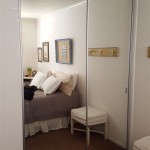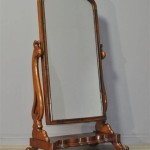Multi-Faceted Mirror Wall
Multi-faceted mirror walls offer a dynamic and versatile design element for various spaces. Utilizing multiple mirrors set at varying angles, these installations create captivating visual effects, expanding perceived space and manipulating light in intriguing ways. This article explores the benefits, applications, design considerations, and installation techniques associated with incorporating multi-faceted mirror walls.
Benefits of Multi-Faceted Mirror Walls
The incorporation of multi-faceted mirror walls provides several advantages:
- Illusion of Increased Space: Reflections from multiple angles create a sense of depth and expanse, making smaller rooms appear larger.
- Enhanced Light Diffusion: Strategic placement can maximize natural light distribution, brightening dimly lit areas.
- Unique Aesthetic Appeal: The interplay of light and reflections adds a dynamic, artistic element to any space.
- Concealment of Imperfections: Clever placement can effectively camouflage architectural flaws or unwanted views.
Applications of Multi-Faceted Mirror Walls
Multi-faceted mirror walls find applications in diverse settings:
- Residential Spaces: Adding visual interest to living rooms, dining areas, hallways, and even bathrooms.
- Commercial Environments: Enhancing the ambiance of restaurants, bars, retail stores, and entertainment venues.
- Art Installations: Serving as a central element in artistic displays and exhibitions.
- Stage and Performance Spaces: Creating dynamic backdrops and enhancing lighting effects for theatrical productions.
Design Considerations for Multi-Faceted Mirror Walls
Several aspects require consideration when designing a multi-faceted mirror wall:
- Mirror Size and Shape: Varying sizes and shapes can create diverse visual effects. From small, geometric tiles to large, irregular shards, the possibilities are extensive.
- Angle and Orientation: The angle at which the mirrors are set determines the complexity and direction of reflections.
- Framing and Mounting: Framing options range from simple metal edging to ornate wooden frames, impacting the overall aesthetic.
- Material Selection: Mirrored glass, acrylic, or specialized metallic finishes offer varying levels of reflectivity and durability.
- Surrounding Décor: The surrounding furniture, colors, and lighting should complement the mirror wall, creating a cohesive design.
- Safety and Security: Utilizing appropriate mounting techniques and safety backing prevents accidents, especially in high-traffic areas.
Installation Techniques for Multi-Faceted Mirror Walls
Installing a multi-faceted mirror wall requires precision and attention to detail:
- Surface Preparation: Ensuring a smooth, clean, and level surface is crucial for proper adhesion and alignment.
- Layout Planning: Precisely mapping out the arrangement of mirrors ensures the desired visual effect.
- Adhesive Selection: Utilizing appropriate adhesives designed for mirrors ensures a secure and lasting bond.
- Mirror Placement and Alignment: Careful placement and alignment of each mirror piece are essential for achieving the intended design.
- Grouting and Finishing: Grouting between mirror pieces can enhance the overall aesthetic, depending on the design.
Maintenance and Cleaning of Multi-Faceted Mirror Walls
Maintaining the pristine appearance of a multi-faceted mirror wall requires regular cleaning:
- Gentle Cleaning Solutions: Using non-abrasive cleaners designed for glass surfaces prevents damage and streaking.
- Soft Cloths and Sponges: Employing soft materials avoids scratching the mirror surfaces.
- Regular Dusting: Regular dusting prevents the buildup of dust and grime, maintaining reflectivity.
Exploring Different Styles of Multi-Faceted Mirror Walls
Multi-faceted mirror walls offer a wide range of stylistic possibilities:
- Geometric Patterns: Utilizing precise geometric shapes creates a structured and modern look.
- Organic and Irregular Designs: Employing irregular shapes and varying angles creates a more fluid and artistic aesthetic.
- Antique or Distressed Finishes: Incorporating antique or distressed mirror finishes adds a touch of vintage charm.
- Colored and Tinted Mirrors: Using colored or tinted mirrors introduces unique hues and reflections.
Lighting Considerations for Multi-Faceted Mirror Walls
Strategic lighting enhances the impact of a multi-faceted mirror wall:
- Accent Lighting: Highlighting specific angles and facets with directional lighting creates dramatic effects.
- Ambient Lighting: Soft, diffused ambient lighting enhances overall reflectivity and creates a warm atmosphere.
- Natural Light Integration: Maximizing natural light sources optimizes the interplay of reflections and enhances brightness.
Materials and Finishes for Multi-Faceted Mirror Walls
A variety of materials and finishes can be utilized for creating multi-faceted mirror walls:
- Traditional Glass Mirrors: Offering classic reflectivity and a range of thicknesses and sizes.
- Acrylic Mirrors: Providing a lightweight and shatter-resistant alternative to glass.
- Metallic Finishes: Utilizing polished metals like stainless steel or brass adds a contemporary and industrial touch.
- Tinted and Colored Mirrors: Introducing unique color variations and reflective qualities.

Multi Faceted Wall Mirror

Multi Faceted Wall Mirror

Pernell Multi Facet Maze Wall Mirror W120

Tutti Multi Faceted Frameless Wall Mirror By Reflect The Enid Hutt Gallery

Mirrorglass Multi Faceted Mirror Wall With Lights Effects By Ettlin Lux

Large Multi Facet Frameless Wall Mirror 390 00

Multi Faceted Wall Mirror

Multi Faceted Wall Mirror

Large 3d Glass Framed Multi Facet Bevelled Wall Mirror Extra 120 X 80cm

Multi Faceted Wall Mirror








